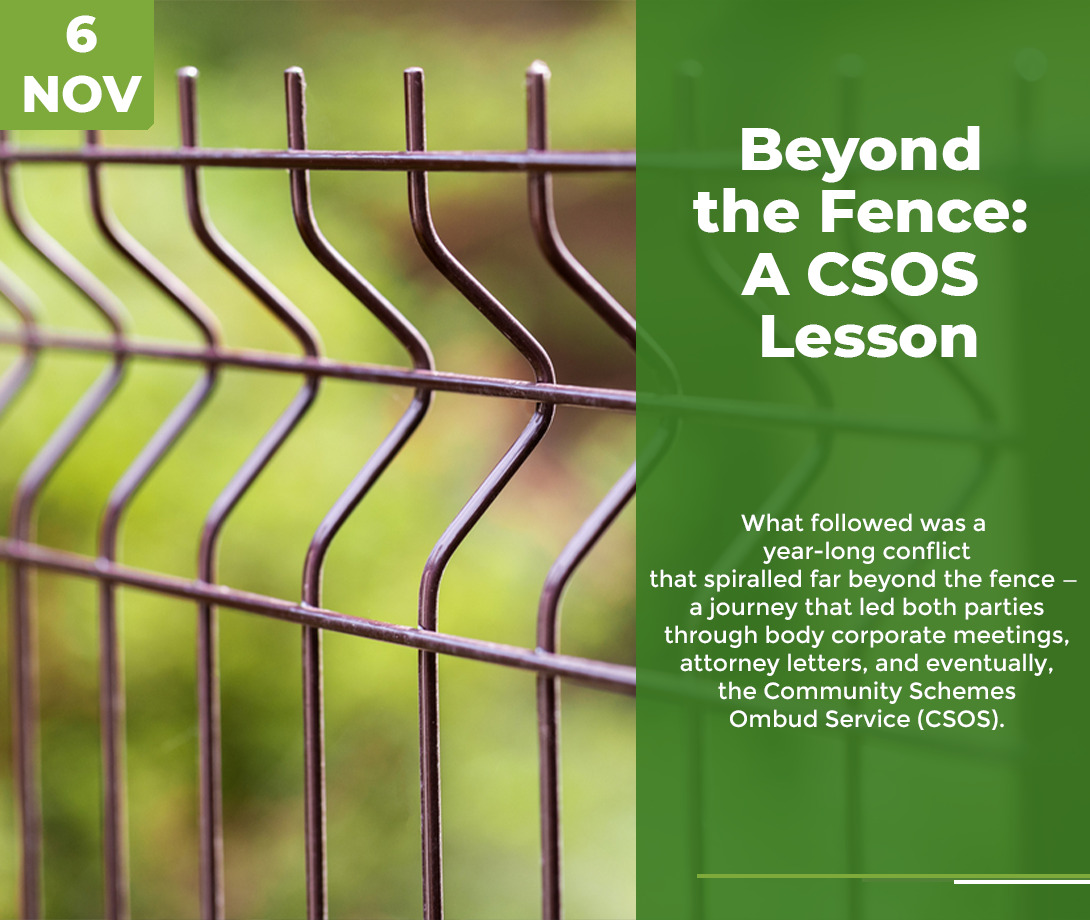By CSOSlive Digest Editorial Team
(Estimated read time: 6 min)
🌿 The Fence That Divided More Than a Garden
It started, as so many community schemes conflicts do, with something small: a fence.
In a quiet sectional title complex in Johannesburg’s northern suburbs, two neighbours — let’s call them Mr Dlamini and Mrs Jacobs — lived side by side for nearly a decade. They greeted each other politely, shared bin day duties, and occasionally exchanged pleasantries about the weather. Until, one day, a new fence went up.
It wasn’t a towering structure — just a simple, neat palisade fence that Mr Dlamini erected to keep his dogs from straying into Mrs Jacobs’ flowerbeds. But to Mrs Jacobs, it was more than metal and bolts. It was a violation of her peace, an obstruction of her garden view, and, most importantly, an unauthorised alteration to the common property.
What followed was a year-long conflict that spiralled far beyond the fence — a journey that led both parties through body corporate meetings, attorney letters, and eventually, the Community Schemes Ombud Service (CSOS).
⚖️ The Case at CSOS: A Familiar Story
When the case finally reached CSOS, it carried all the hallmarks of shared residential estate living tension:
- Perception vs Procedure: Mrs Jacobs believed her rights had been infringed, while Mr Dlamini insisted he was acting reasonably.
- Authority Ambiguity: The body corporate couldn’t decide whether the fence counted as “exclusive use area improvement” or “unauthorised structure.”
- Emotional Escalation: Both parties stopped attending meetings — communication had broken down completely.
CSOS adjudicator Case No. ST/0214/23 (fictionalized but representative of real rulings) found that:
“While the respondent’s intentions were not malicious, the construction of the fence without written trustee approval constitutes a breach of the scheme’s conduct rules. The fence is to be removed or regularised within 30 days.”
The Ombud also noted that both parties had failed to use the internal dispute resolution mechanisms before escalating — a common and avoidable mistake.
💔 The Human Side: Why Small Conflicts Escalate
What’s striking about cases like this isn’t the ruling — it’s the emotional weight behind them.
A fence is rarely just a fence. It’s a symbol of control, space, and safety — deeply human needs.
In community schemes, those needs intersect in small, shared environments where private boundaries and public governance coexist. When trust erodes, every act feels personal.
Psychologists call this the “proximity paradox”: the closer people live, the easier it is for small irritations to turn into conflicts. Without structured dialogue and emotional literacy, even minor issues — like bin placement, parking, or a fence — can ignite complex disputes.
Lessons from the CSOS Ruling
1. Communication First, Complaints Later
Before drafting formal complaints, trustees and residents should insist on direct, mediated communication. Many CSOS adjudicators view premature escalation as poor governance, not justice.
2. Know Your Governance Documents
Most sectional title schemes or HOAs have conduct rules that require trustee approval for any change to common property. Always ask for this in writing — not via WhatsApp or at a braai.
3. Trustees Are Not Referees — They’re Leaders
A recurring theme in CSOS decisions is trustee inaction. Leadership in a community scheme isn’t about avoiding conflict; it’s about managing it constructively before it reaches the Ombud’s desk.
4. Emotional Intelligence Prevents Legal Costs
Community living isn’t only about legal compliance — it’s about empathy. Recognising the humanity in your neighbour can often resolve what a thousand legal words cannot.
📊 Sidebar: The Rise of CSOS Disputes
| Year | Total Cases Lodged | Most Common Issue |
| 2020 | 4,500 | Levy disputes |
| 2021 | 5,900 | Governance and approval conflicts |
| 2022 | 6,200 | Common property alterations (like fences!) |
| 2023 | 7,300 | Behavioural disputes and noise complaints |
Source: CSOS Annual Reports (2020–2023)
The data paints a clear picture: as community schemes grow, so do disputes. But the volume of conflict doesn’t have to equal chaos — if we learn the lessons behind each case.
💡 What This Means for You
If you’re a trustee, this case is a reminder:
Governance is 20% paperwork and 80% communication.
If you’re a homeowner, remember:
Living in a community means trading a little independence for a lot of collective peace.
And if you’re simply an observer of how societies function in miniature, CSOS rulings are case studies in civility. Each dispute is a mirror reflecting how we share space, power, and respect.
The Final Reflection
When asked, months later, what she learned from the process, Mrs Jacobs reportedly said:
“I realised I was angry because I felt unseen — not because of the fence.”
And Mr Dlamini replied,
“I just wanted my dogs to be safe. I didn’t think to ask.”
Two ordinary people, one extraordinary lesson: our communities aren’t built on walls or fences — they’re built on conversations.
🗞️ CSOS Digest Takeaway
| Principle | Description |
| Transparency | Always communicate intentions openly before acting. |
| Governance | Follow formal approval processes to avoid escalation. |
| Empathy | See the human behind the complaint. |
| Dialogue | The shortest path to peace is usually a conversation. |
✍️ Closing Note
CSOSlive Digest exists to surface stories like this — not to name or shame, but to learn.
Every ruling hides a human story. Every case, a chance to build better communities.
📬 Subscribe
Get the CSOSlive Weekly Digest in your inbox — summaries of new rulings, trustee tips, and behind-the-scenes stories shaping South Africa’s community schemes.
👉 [Join the List at csoslive.com/subscribe]
About CSOSlive Digest
CSOSlive Digest is an independent commentary and storytelling platform focused on the Community Scheme Ombud Service (CSOS) and shared living governance across South Africa. We uncover the lessons, the conflicts, and the human stories behind community living — helping trustees, homeowners, and managing agents build more transparent, harmonious communities.

